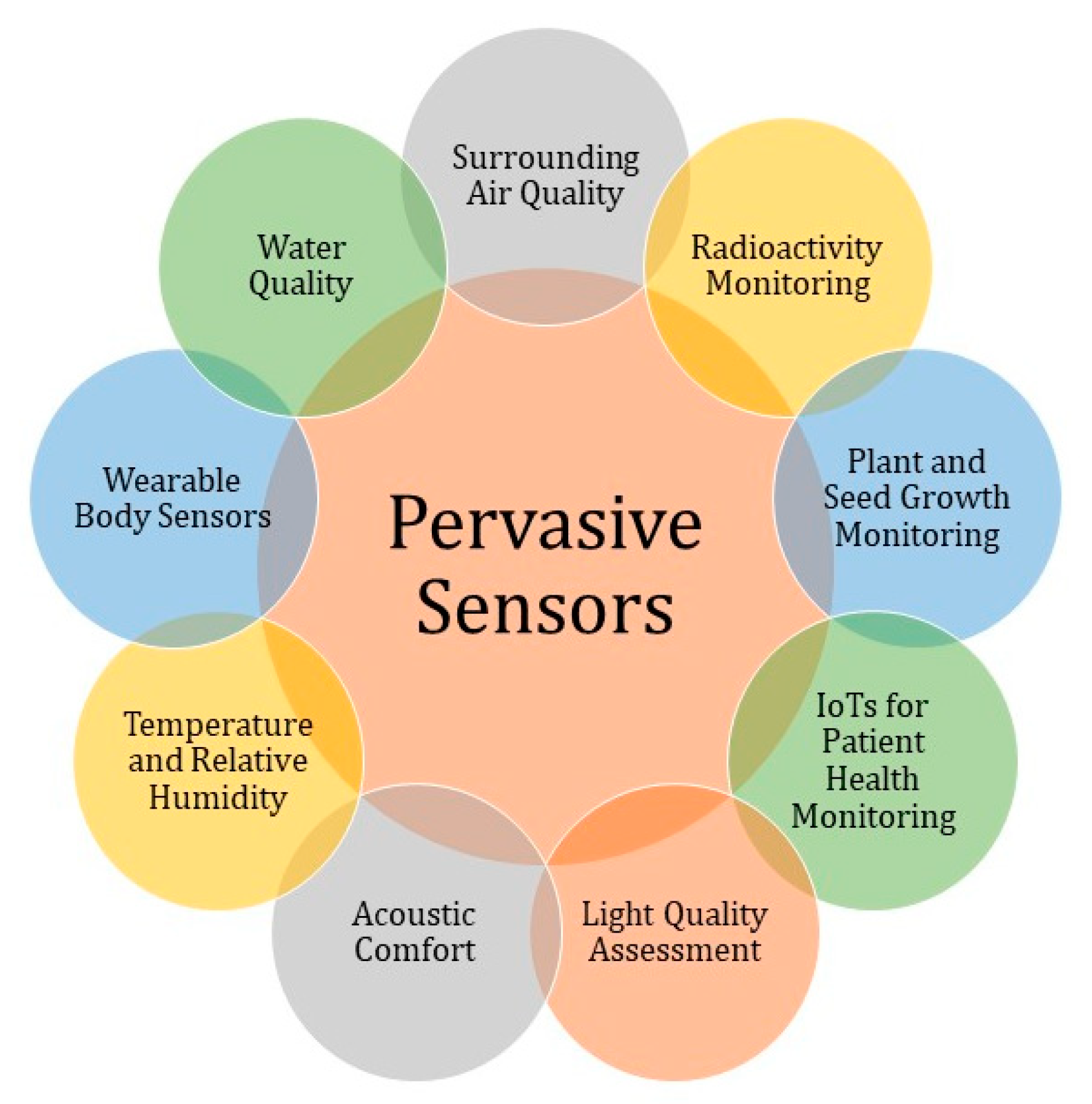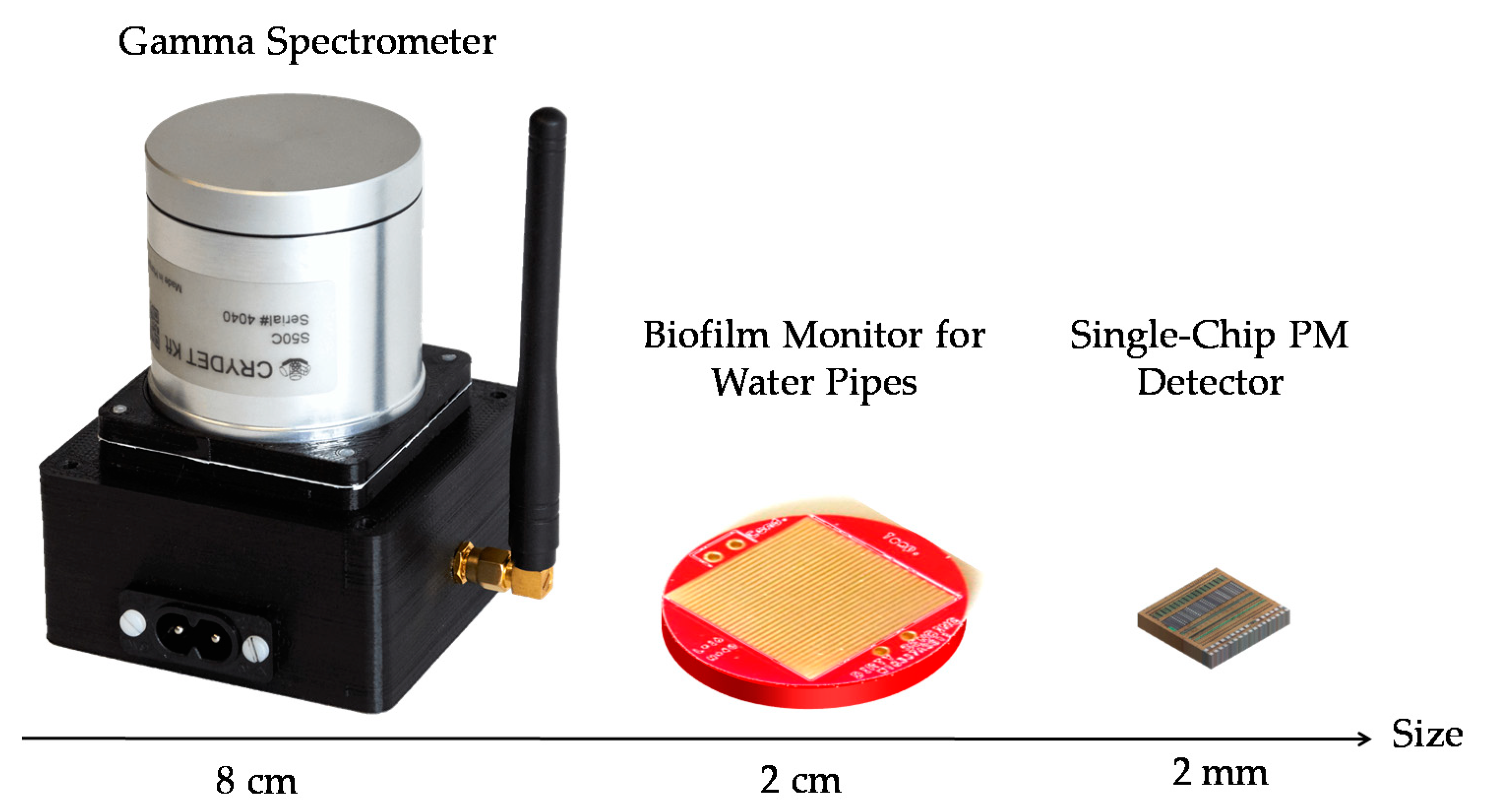Miniaturized Pervasive Sensors for Indoor Health Monitoring in Smart Cities
Abstract
:1. Introduction
2. Peculiar Aspects of Indoor Sensors Networks
3. Water, Air and Radioactivity Monitoring
4. Literature Review: Trends and Impact
5. Machine Learning
6. Conclusions
Author Contributions
Funding
Conflicts of Interest
References
- Ullo, S.L.; Sinha, G.R. Advances in Smart Environment Monitoring Systems Using IoT and Sensors. Sensors 2020, 20, 3113. [Google Scholar] [CrossRef]
- Carminati, M.; Turolla, A.; Mezzera, L.; Di Mauro, M.; Tizzoni, M.; Pani, G.; Zanetto, F.; Foschi, J.; Antonelli, M.; Antonelli, M. A self-powered wireless water quality sensing network enabling smart monitoring of biological and chemical stability in supply systems. Sensors 2020, 20, 1125. [Google Scholar] [CrossRef] [PubMed] [Green Version]
- Ciccarella, P.; Carminati, M.; Sampietro, M.; Ferrari, G. Multichannel 65 zF rms resolution CMOS monolithic capacitive sensor for counting single micrometer-sized airborne particles on chip. IEEE J. Solid-State Circuits 2016, 51, 2545–2553. [Google Scholar] [CrossRef]
- Carminati, M.; Ferrari, G.; Sampietro, M. Emerging miniaturized technologies for airborne particulate matter pervasive monitoring. Measurement 2017, 101, 250–256. [Google Scholar] [CrossRef]
- Kumar, P.; Morawska, L.; Martani, C.; Biskos, G.; Neophytou, M.; Di Sabatino, S.; Bell, M.; Norford, L.; Britter, R. The rise of low-cost sensing for managing air pollution in cities. Environ. Int. 2015, 75, 199–205. [Google Scholar] [CrossRef] [Green Version]
- Purwanto, P.; Suryono, S.; Sunarno, S. Design of Air Quality Monitoring System Based On Web Using Wireless Sensor Network. J. Phys. Conf. Ser. 2019, 1295, 012043. [Google Scholar] [CrossRef]
- Liang, Y. Air Quality Measurement Using Portable Sensors; Cooperative Extension Service; University of Arkansas: Fayetteville, AR, USA, 2017. [Google Scholar]
- Schütze, A. Integrated sensor systems for indoor applications: Ubiquitous monitoring for improved health, comfort and safety. Procedia Eng. 2015, 120, 492–495. [Google Scholar] [CrossRef] [Green Version]
- Karagulian, F.; Barbiere, M.; Kotsev, A.; Spinelle, L.; Gerboles, M.; Lagler, F.; Redon, N.; Crunaire, S.; Borowiak, A. Review of the performance of low-cost sensors for air quality monitoring. Atmosphere 2019, 53, 506. [Google Scholar] [CrossRef] [Green Version]
- Oelen, A.; van Aart, C.J.; de Boer, V. Measuring surface water quality using a low-cost sensor kit within the context of rural africa. In Proceedings of the 5th International Symposium “Perspectives on ICT4D” co-located with 10th ACM Web Science Conference (WebSci’18), Amsterdam, The Netherlands, 27 May 2018. [Google Scholar]
- Smith, B. Overview of Water Quality Sensors as Pertinent to Water Distribution Systems There. 2018. Available online: https://www.azosensors.com/article.aspx?ArticleID=1444 (accessed on 8 January 2021).
- Farid, M.M.; Prawito; Susila, I.P.; Yuniarto, A. Design of early warning system for nuclear preparedness case study at Serpong. AIP Conf. Proc. 2017, 1862, 030067. [Google Scholar]
- Buruiană, V.; Oprea, M. A microcontroller-based radiation monitoring and warning system. In Proceedings of the IFIP International Conference on Artificial Intelligence Applications and Innovations, Halkidiki, Greece, 27–30 September 2012; pp. 380–389. [Google Scholar]
- Ooi, K.; Yasutomo, K.; Suzuki, Z. Nuclear facility radiation monitoring system. Fuji Electr. Rev. 2007, 53, 114–118. [Google Scholar]
- Tiele, A.; Esfahani, S.; Covington, J. Design and development of a low-cost, portable monitoring device for indoor environment quality. J. Sens. 2018, 2018, 5353816. [Google Scholar] [CrossRef]
- Gamboa, H.; Silva, F.; Silva, H. Patient tracking system. In Proceedings of the 2010 4th International Conference on Pervasive Computing Technologies for Healthcare, Munchen, Germany, 22–25 March 2010; pp. 1–2. [Google Scholar]
- Huzooree, G.; Khedo, K.K.; Joonas, N. Pervasive mobile healthcare systems for chronic disease monitoring. Health Inform. J. 2019, 25, 267–291. [Google Scholar] [CrossRef] [PubMed]
- Carminati, M.; Kanoun, O.; Ullo, S.L.; Marcuccio, S. Prospects of Distributed Wireless Sensor Networks for Urban Environmental Monitoring. IEEE Aerosp. Electron. Syst. Mag. 2019, 34, 44–52. [Google Scholar] [CrossRef]
- Turolla, A.; Di Mauro, M.; Mezzera, L.; Antonelli, M.; Carminati, M. Development of a miniaturized and selective impedance sensor for real-time slime monitoring in pipes and tanks. Sens. Actuator B Chem. 2019, 281, 288–295. [Google Scholar] [CrossRef]
- Carminati, M.; Mezzera, L.; Turolla, A.; Pani, G.; Tizzoni, M.; Di Mauro, M.; Antonelli, M. Flexible impedance sensor for in-line monitoring of water and beverages. In Proceedings of the 2019 IEEE International Symposium on Circuits and Systems (ISCAS), Sapporo, Japan, 26–29 May 2019; pp. 1–4. [Google Scholar]
- Carminati, M.; Montagnani, G.L.; Lorusso, L.; Lavelli, E.; Di Vita, D.; Morandi, G.; Rizzacasa, P.; Fiorini, C. Wireless and robust radioactivity detector for environmental monitoring. In Proceedings of the 2019 IEEE Nuclear Science Symposium and Medical Imaging Conference (NSS/MIC), Manchester, UK, 26 October–2 November 2019; pp. 1–3. [Google Scholar]
- Ullo, S.L.; Khare, S.K.; Bajaj, V.; Sinha, G.R. Hybrid computerized method for environmental sound classification. IEEE Access 2020, 8, 124055–124065. [Google Scholar] [CrossRef]
- Addabbo, P.; di Bisceglie, M.; Galdi, C.; Ullo, S.L. The hyperspectral unmixing of trace-gases from ESA SCIAMACHY reflectance data. IEEE Geosci. Remote Sens. Lett. 2015, 12, 2130–2134. [Google Scholar] [CrossRef]
- Carminati, M.; Ferrari, G.; Grassetti, R.; Sampietro, M. Real-time data fusion and MEMS sensors fault detection in an aircraft emergency attitude unit based on Kalman filtering. IEEE Sens. J. 2012, 12, 2984–2992. [Google Scholar] [CrossRef] [Green Version]
- Kuzlu, M.; Pipattanasomporn, M.; Rahman, S. Review of communication technologies for smart homes/building applications. In Proceedings of the 2015 IEEE Innovative Smart Grid Technologies-Asia (ISGT ASIA), Bangkok, Thailand, 3–6 November 2015; pp. 1–6. [Google Scholar]
- Buonanno, L.; di Vita, D.; Carminati, M.; Fiorini, C. A directional gamma-ray spectrometer with microcontroller-embedded machine learning. IEEE J. Emerg. Sel. Top. Circuits Syst. 2020, 10, 433–443. [Google Scholar] [CrossRef]
- Ullo, S.L.; Langenkamp, M.S.; Oikarinen, T.P.; DelRosso, M.P.; Sebastianelli, A.; Sica, S. Landslide geohazard assessment with convolutional neural networks using sentinel-2 imagery data. In Proceedings of the IGARSS 2019-2019 IEEE International Geoscience and Remote Sensing Symposium, Yokohama, Japan, 28 July–2 August 2019; pp. 9646–9649. [Google Scholar]
- Torun, H.M.; Pardue, C.; Belleradj, M.L.F.; Davis, A.K.; Swaminathan, M. Machine learning driven advanced packaging and miniaturization of IoT for wireless power transfer solutions. In Proceedings of the 2018 IEEE 68th Electronic Components and Technology Conference (ECTC), San Diego, CA, USA, 29 May–1 June 2018; pp. 2374–2381. [Google Scholar]
- Ravì, D.; Wong, C.; Deligianni, F.; Berthelot, M.; Andreu-Perez, J.; Lo, B.; Yang, G.Z. Deep learning for health informatics. IEEE J. Biomed. Health Inform. 2016, 21, 4–21. [Google Scholar] [CrossRef] [Green Version]
- Namuduri, S.; Narayanan, B.N.; Davuluru, V.S.P.; Burton, L.; Bhansali, S. Deep Learning Methods for Sensor Based Predictive Maintenance and Future Perspectives for Electrochemical Sensors. J. Electrochem. Soc. 2020, 167, 037552. [Google Scholar] [CrossRef]
- Medeiros, J.; Khreis, H. How emerging technology and its integrations is advancing our understanding of urban and traffic-related air pollution. In Traffic-Related Air Pollution; Elsevier: Amsterdam, The Netherlands, 2020; pp. 563–596. [Google Scholar]
- Sebastianelli, A.; Mauro, F.; Di Cosmo, G.; Passarini, F.; Carminati, M.; Ullo, S.L. AIRSENSE-TO-ACT: A Concept Paper for COVID-19 Countermeasures Based on Artificial Intelligence Algorithms and Multi-Sources Data Processing. ISPRS Int. J. Geo-Inf. 2021, 10, 34. [Google Scholar]
- Available online: https://www.dyson.com/newsroom/overview/update/june-2020/dyson-investigates-lockdown-air-quality#:~:text=Dyson’s%20air%20quaity%20backpack%2C%20which,pollution%20during%20and%20after%20lockdown (accessed on 8 January 2021).
- Evjen, T.Å.; Hosseini Raviz, S.R.; Petersen, S.A.; Krogstie, J. Smart Facility Management: Future Healthcare Organization through Indoor Positioning Systems in the Light of Enterprise BIM. Smart Cities 2020, 3, 40. [Google Scholar] [CrossRef]






| Title | Usage | Method | Salient Features and Limitations |
|---|---|---|---|
| Chemical exposure monitor (6,7) | Standard gas concentration measurement in workplace | Portable DRM apparatus using a photoionization detector (PID) and real-time location system (RTLS) | Calibration against certified isobutylene; direct reading of location using laser; risk due to chemical sensor |
| Low cost monitoring of emissions (8) | Monitoring of temperature, humidity, PM2.5, PM10, total VOCs (×3), CO2, CO, illuminance and sound levels in indoor environment | Low Cost Environment Monitoring using Sensors | Customization and flexibility; monitoring of parameter variations; specific event based |
| Environmental sound classification (9) | Environmental sound monitoring; structured noise and sound events with strong harmonic contents | Hybrid deep learning model | Accurate monitoring, applicable in real time; non-stationary signals; different levels of sound pose difficulty |
| Wireless water quality sensing network (7) | Thin deposits in indoor water sources | Multi-parameter sensing node embedded system with miniaturized slime monitor | Biological and chemical stability; early warning functions; predictive maintenance; efficient process management; surface fouling |
| Trace-gases monitoring (10) | Traces of gases in surrounding atmosphere | Blind source separation method | Easy detection; accurate with minimum dependence criterion of independent component analysis |
| Threat | Agent | Sensing Technologies | References | |
|---|---|---|---|---|
| Biological | Aerosol | Physical detection principles | Light scattering | Challenges in detection, identification and monitoring of indoor airborne chemical-biological agents [2] |
| Laser induced fluorescence | ||||
| Flame photometric detection | ||||
| Biochemical detection principles | Affinity based detection | |||
| Nucleic acid-based techniques | ||||
| Chemical | Chemical warfare agents (CWAs) and toxic industrial chemicals (TICs). | Resistive and Capacitive Electronic Gas Sensors | [2,15] | |
| Flame ionization detection | ||||
| Infrared spectrometry | ||||
| Photo acoustic spectroscopy | ||||
| Photo ionization detection | ||||
| Mass spectrometry | ||||
| Security | Inefficient existing security technology for big data; attacks, software vulnerabilities | Block chain | IoT and security challenges [1,10] | |
| Fog computing | ||||
| Machine learning | ||||
| Edge computing | ||||
Publisher’s Note: MDPI stays neutral with regard to jurisdictional claims in published maps and institutional affiliations. |
© 2021 by the authors. Licensee MDPI, Basel, Switzerland. This article is an open access article distributed under the terms and conditions of the Creative Commons Attribution (CC BY) license (http://creativecommons.org/licenses/by/4.0/).
Share and Cite
Carminati, M.; Sinha, G.R.; Mohdiwale, S.; Ullo, S.L. Miniaturized Pervasive Sensors for Indoor Health Monitoring in Smart Cities. Smart Cities 2021, 4, 146-155. https://0-doi-org.brum.beds.ac.uk/10.3390/smartcities4010008
Carminati M, Sinha GR, Mohdiwale S, Ullo SL. Miniaturized Pervasive Sensors for Indoor Health Monitoring in Smart Cities. Smart Cities. 2021; 4(1):146-155. https://0-doi-org.brum.beds.ac.uk/10.3390/smartcities4010008
Chicago/Turabian StyleCarminati, Marco, Ganesh R. Sinha, Samrudhi Mohdiwale, and Silvia L. Ullo. 2021. "Miniaturized Pervasive Sensors for Indoor Health Monitoring in Smart Cities" Smart Cities 4, no. 1: 146-155. https://0-doi-org.brum.beds.ac.uk/10.3390/smartcities4010008







